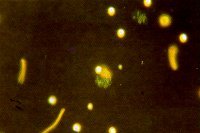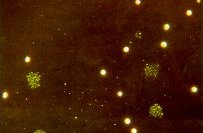Exploding Zoospores
Using biosurfactants to control plant pathogens
It began as many scientific breakthroughs do — it was an accident.
In 1995, Michael Stanghellini, then a plant pathologist in the Department
of Plant Pathology, was looking for ways to control fungal diseases
in plants. In a greenhouse on campus, he injected hydroponic plant specimens
with different pathogens and then added fungicides. During a routine
check he noticed that in one unit inoculated with the pathogen, not
a single plant had died. Even more odd, he saw that the solution in
the unit was foaming extensively.
 After
considering and dismissing several causes, he contacted Raina Miller,
a microbiologist in the Department of Soil, Water and Environmental
Science. They had never worked together before. They isolated a bacterium
from the recirculating nutrient solution of the hydroponic unit, and
identified it as Pseudomonas aeruginosa. They found that the
bacterium was synthesizing a biosurfactant that was responsible for
the foaming in the nutrient solution. After
considering and dismissing several causes, he contacted Raina Miller,
a microbiologist in the Department of Soil, Water and Environmental
Science. They had never worked together before. They isolated a bacterium
from the recirculating nutrient solution of the hydroponic unit, and
identified it as Pseudomonas aeruginosa. They found that the
bacterium was synthesizing a biosurfactant that was responsible for
the foaming in the nutrient solution.
"Biosurfactants are like a detergent or a soap, but are made naturally
in the environment by microorganisms," Miller says. At the time, she
had been studying the use of biosurfactants for waste management. "We
were looking at the way biosurfactants could clean up soils by physically
washing the contaminants from the soils and pulling heavy metals or
toxic organics like petroleum from them."
Stanghellini's work focused on zoosporic plant pathogens, which cause
the most economically damaging plant diseases in the world. He had been
trying to find the most efficient way to control them using the only
means then available: chemical fungicides.
 These
fungus diseases include the downy mildews, such as downy mildew of grape,
cucumber, pumpkin, pepper and melons; root rots such as Pythium spp.;
and the notorious late blight of potato, Phytophthora infestans,
which destroyed the potato crop in Ireland during the last century.
All of these diseases affect Arizona crops. These
fungus diseases include the downy mildews, such as downy mildew of grape,
cucumber, pumpkin, pepper and melons; root rots such as Pythium spp.;
and the notorious late blight of potato, Phytophthora infestans,
which destroyed the potato crop in Ireland during the last century.
All of these diseases affect Arizona crops.
Why has it been so difficult to control zoosporic plant diseases? These
fungi undergo a life stage called a zoospore, which has no cell wall
and is very mobile. It has a membrane and two tails. The zoospore can
encyst rapidly, developing cell walls within 60 seconds. The zoospore
stage is therefore highly infectious and spreads quickly.
Miller and Stanghellini wanted to know just how the protective bacteria
were killing the fungus, so they isolated the active material and tested
it on a series of different zoosporic plant pathogens. They found that
the biosurfactant produced by the bacteria was able to lyse, or destroy
cell membranes, with dramatic results.
"We found that if you take zoospores and expose them to these rhamnolipids,
which are a type of biosurfactant, they explode," Miller says. The rhamnolipids
slice into the membrane, separating it enough to release the contents
of the zoospores. Stanghellini and Miller also learned that the bacteria
produce large amounts of rhamnolipid in the presence of a carbon source
such as olive oil, glucose or soybean oil.
Their next step was to find out if the rhamnolipid-producing bacteria
occurred naturally on field-grown plants. They located the bacteria
on the roots and leaves of cucumber, tomato and cantaloupe. Then they
conducted a series of greenhouse studies using pepper plants to determine
where the biosurfactant could be applied on the plant, and which rhamnolipids
worked best on each pathogen.
"We've added it to the roots and the leaves, and we've found that
just the rhamnolipid by itself will provide control, or control can
be achieved by adding the bacteria combined with a food source to allow
rhamnolipid synthesis," Miller says. "We still have to figure out how
to deliver it to the crop, though."
Miller says that potential application methods include
1) spraying the biosurfactant on leaf surfaces, or
2) spraying on the Pseudomonas bacteria in an emulsion (food source)
to stimulate the production of the biosurfactant.
Some fungal pathogens strike during warm weather, others flourish
during cool days and nights, and most prefer moist conditions. These
factors would affect the timing of biosurfactant applications. "You
could predict the times of year when these zoospores would be likely
to spread – during wet or rainy weather, for example – and
you could apply the appropriate biosurfactant maybe two or three times
a year during that season," Miller suggests.
She and Stanghellini have applied for patents for this work, and they
continue to study the way the rhamnolipids affect crop diseases in Arizona.
The working association that began with an accident in a greenhouse
has evolved into an ongoing research team. Others associated with this
project include post-doctoral student Yimin Zhang, working with Miller;
and Scott Rasmussen, D-H. Kim, and Pat Rorabaugh, technical staff working
with Stanghellini.
Both scientists believe that the pathogens targeted by the rhamnolipids
probably won't develop resistance to them because the pathogen would
have to undergo a complete structural change in its plasma membrane,
a major chemical alteration that differs from the way insects quickly
develop resistance to pesticides.
Miller and Stanghellini admit that it's probably impossible for any
single rhamnolipid producing strain of bacteria to control all zoosporic
plant pathogens under all environmental conditions. Yet the prospect
remains that biosurfactants produced by bacteria may eventually enable
growers to control some of their worst fungus diseases without using
chemical pesticides.
Article written by Susan McGinley, ECAT, College of
Agriculture
This is part of the 1997 Arizona Experiment Station Research Report
This document is located at http://ag.arizona.edu/pubs/general/resrpt1997/exploding_zoospores.html
Return to Index for 1997 report
Researcher:
Raina Miller
Department of Soil, Water and Environmental Science
(520) 621-7231
rmiller@ag.arizona.edu
|